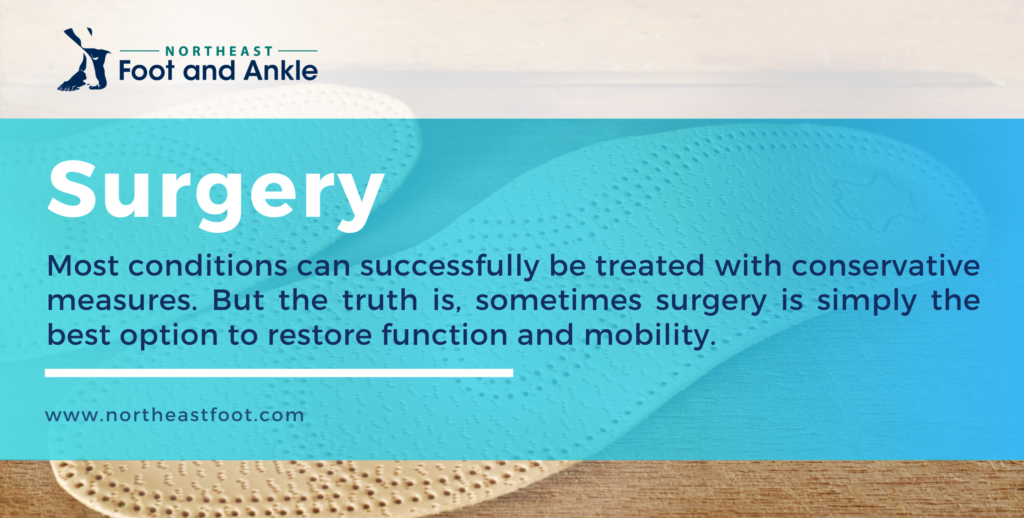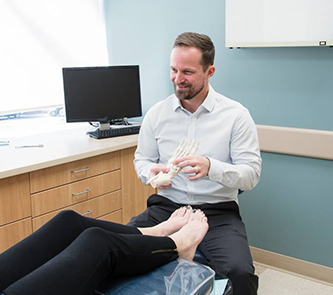Surgery
There are many different conditions for which surgical procedures may be performed. When necessary, surgical procedures can relieve chronic pain from deformities, sports injuries, and other conditions that do not respond successfully to conservative treatments.
The “when necessary” part is important to emphasize, as surgery is not always required.
At Northeast Foot and Ankle, we use surgical correction after non-surgical treatments – like physical therapy, rest, medications, footwear modifications, etc. – are no longer effective, and/or the pain you are experiencing has started to interfere in your daily life.
In these cases, a surgical procedure will likely be your best option for long-lasting pain relief, as well as restoration of function, mobility, and flexibility to the foot and ankle. For some patients, surgery can also allow for more footwear options.
Conditions Which May Require Surgical Intervention
While fractures are common types of injuries that require surgery, other conditions can benefit as well. They include:
- Bunions and hammertoes. When toe deformities are causing chronic pain and difficulty when walking and wearing shoes, we will likely recommend surgery. Note that bunions and hammertoes are progressive conditions and can only be corrected with surgical methods. (Conservative measures are often enough to manage painful symptoms and delay surgery if the condition is still in an early stage.)
- Plantar fasciitis. In rare occasions, surgery may be necessary to resolve a severe case of plantar fasciitis (the most common source of heel pain in adults). Fortunately, conservative measures are usually able to provide relief from painful symptoms.
- Ankle arthritis. Surgery for ankle arthritis will depend on the severity of the condition. It may be that you only need minimally invasive surgery to “clean up” any existing bone spurs or fragments of cartilage from the joint or, if your condition is more severe, we may recommend a joint fusion or a total joint replacement.
- Tendon Injuries. When a tendon has developed chronic inflammation or ruptured, surgery may be necessary to correct the problem and restore function and mobility to the injured foot.
- Neuromas. To address this condition, surgery may be needed to remove the affected nerve that is causing pain and discomfort. However, if any underlying condition is what caused the development of the neuroma, said condition will likely need to be addressed as well in order to prevent the problem from returning in the future.
Surgeries for these conditions can correct existing problems and help lessen, or even completely eliminate, the pain and discomfort you have been experiencing. And if you don’t see your condition listed here, no worries! Our foot and ankle experts are able to perform surgical procedures for a wide range of lower limb problems beyond what is listed here.
Getting Ready for Surgery
Usually the benefits of surgery outweigh the negatives of the recovery period. And since you may not be able to walk on your foot afterward, it’s important to prepare in advance for your healing process. Here are a few things to think about before going in for surgery:
- Stock up on necessary items. Everyday essentials like grocery shopping and food preparation may become difficult. You should have a loved one, friend, or service available to help you with this task.
- Prepare your home. If your house has stairs, will you be able to get up and down on your own? Are your rails sturdy enough to support the added weight?
- Make your recovery area accessible. You may need to temporarily move a bed to be closer in proximity to your bathroom, in order to make bathroom trips easier, for example.
If you are not sure what to do about these situations, we are happy to help!

Recovering from Surgery
After you have gone through surgery, you can expect to be sore or stiff. You may have to wear a boot, shoe, or cast for a while, be careful of your wounds, and avoid bearing weight on the foot. We will also provide you with special instructions and schedule follow-up appointments – and should follow these instructions to a T if you want optimal results from your procedure.
Of course, your recovery plan will depend on the specific surgical procedure. However, the following steps are usually always included in post-op recovery instructions:
- Keep weight off the foot as much as possible.
- Apply ice to your foot or ankle in 30-minute increments with a thin towel between the ice pack and your skin.
- Elevate. Keep your foot elevated above hip level for the first 3 days, as much as possible.
- Using crutches? Watch this video. (jump to the 35-second mark)
- Using a knee walker/roller? Watch this video.
Another post-op treatment option we may recommend is multiwave locked system (MLS) laser therapy, an advanced treatment that promotes pain relief, reduction of inflammation, and faster healing.
We will likely also recommend at-home exercises or physiotherapy to help prevent stiffness and muscle atrophy, and you should follow these exercises very carefully. And if you experience any concerning symptoms, like excessive pain and inflammation, or notice the surgical site has become infected, you should call our office right away.
Find Expert Surgical Options at Northeast Foot and Ankle
Foot and ankle surgery can help with a variety of conditions. If you are experiencing pain, and other treatments are not working, surgery may be the solution. Contact Northeast Foot and Ankle to make an appointment today so we can discuss if surgery is the best option for you.
Simply call us at (603) 431-6070 or fill out our online contact form to have a member of our staff reach out to you.
Pay Your Bill
Make a payment online through our payment portal or Care Credit!
Portsmouth Office
14 Manchester Square, Suite 250
Portsmouth, NH 03801
Nashua Office
17 Riverside Street, Suite 205
Nashua, NH 03062
Website Hosted by SC Digital



